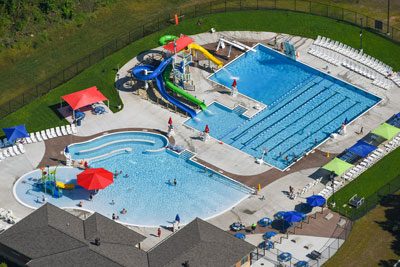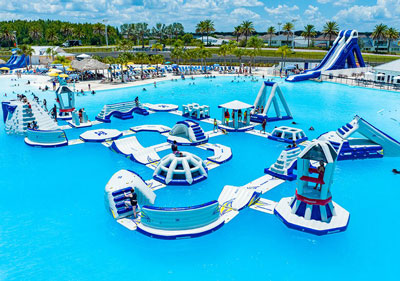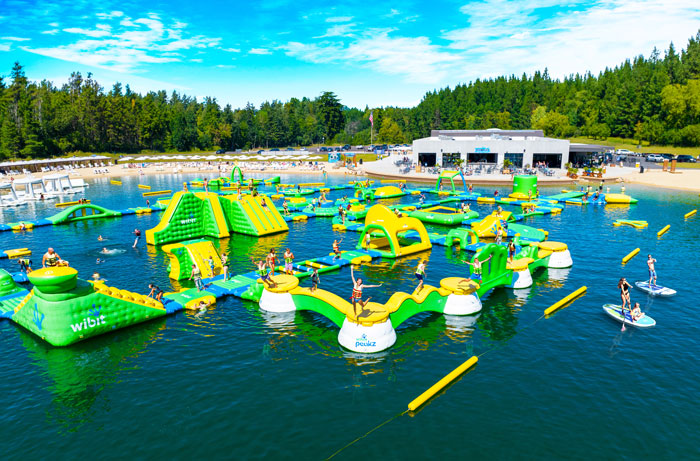Whether it’s the soothing lull of waves, the exhilarating rush of a water slide or the pure joy of splashing around, humans have

an undeniable attraction to water. This magnetic draw for people of all ages makes open-water and pool environments a popular hub for family activities. From natural recreation ponds and dazzling lagoons to pools and aquatic centers, the possibilities are endless.
If you’re envisioning an enchanting family aquatic park, here are 10 practical considerations to help determine which type is best suited to set you up for
success.
Typically, a family aquatic park hosts its exhilarating activities with either an open-water or enclosed-water concept. Each of the three main types offers the possibility for a diverse range of attractions that cater to varied tastes:
- Natural recreation ponds, lakes, quarries, etc. (open water)
- Manufactured, chlorinated lagoons (open water)
- Chlorinated pools, aquatic centers (enclosed water)
10 Things to Consider
1. Who Are You Looking to Serve?
Picture your perfect park-goer: families with energetic kids, adventurous thrill-seekers, or perhaps a blend of all ages? Defining your audience is like picking the cast for your blockbuster hit—it shapes the storyline. Are you catering to locals, tourists or both? If you’re within 90 minutes of a tier 1-3 city, you have a golden opportunity to attract a steady stream of visitors. Also, think about their swimming skills—are you drawing in pros who love a challenge, or casual swimmers who prefer gentle fun?
2. What Does Your Audience Desire?
Do they seek high-energy active activities like Aqua Parks, waterslides and ziplines, or do they prefer more passive recreation like lounging and soaking up the sun? A balanced park might offer a mix of both, ensuring there’s something for everyone. Including at least seven different amenities can enhance the park’s appeal, catering to diverse interests and thrills for all ages. Your park could be an urban oasis, a destination getaway or a convenient local attraction. The choice between scripted and unscripted play also matters—will your park have structured activities and attractions with lines, or offer free play areas for spontaneous fun?
3. Who Do You Want to Be?
Who is your park in the grand story of aquatic fun? Is it a summer must-visit or a year-round favorite? Will it be a major destination that families plan vacations around, or an added bonus to a larger attraction? Perhaps your community is in a more arid part of the country so providing a self-sustaining water amenity can draw more families to your region and improve your local economy. Your park’s identity will guide everything from design and marketing to daily operations.
4. What Are Your Goals?
If you aim for a high return on investment (ROI), consider features that attract large crowds and generate significant revenue. Alternatively, if the park is intended as a community amenity or a boost to local tourism, focus on creating an enjoyable, inclusive environment. Decide if this is a commercial venture, a public investment or a lifestyle business that aligns with personal passions and community values to differentiate itself from other attractions in the area.
5. How Do You Envision Your Operations?

Will it be a free-entry public space, a paid-entry park or included with other services or nearby accommodations? Local regulations for pools versus ponds, staffing requirements like lifeguards versus attendants, and the ongoing costs of maintenance and risk management are crucial factors. Staffing is a growing challenge, so limiting the need for certified staff can make operations easier. These decisions affect the day-to-day running of the park and its long-term sustainability.
6. What Is Your Geography Like?
Seasonal climate variations impact operational schedules and infrastructure needs. In regions with harsh winters, an indoor aquatic center ensures year-round enjoyment. Warmer climates can support outdoor facilities, allowing visitors to bask in the sunshine at a fraction of the cost and emphasize a “back to nature” experience—with considerably less maintenance. Understanding the local context helps tailor your park to complement existing attractions and leverage the natural landscape.
7. What Is Your Population Base?
Your potential visitor base within a 90-minute drive is crucial. Ideally, you want access to a population base of approximately 800,000 people, increasing the potential for high visitor numbers and revenue. Are there local events that draw in visitors regularly or drive attendance for an annual event? If you’re in a more remote area, your park needs to be a must-see destination that attracts travelers for longer stays, with lodging options on site. Tourism can compensate for the smaller local population.
8. What Are Your Site’s Natural Assets?
Evaluate the natural assets of your site, such as beauty, soil type, bedrock, water tables, topography and existing water features like quarries or natural springs. Utilizing natural assets can enhance the park’s appeal and reduce construction costs. A natural setting might involve a recreation pond, utilizing existing water bodies or creating new ones in harmony with the landscape. A flat parcel with existing utilities may be more conducive to a waterpark model.
9. What Does Your Competition Look Like?
Identify other attractions within a 90-minute radius. Understanding your competition helps identify gaps in the market and potential differentiators for your park. Offering unique features or superior experiences can attract visitors away from competing parks. Analyze their strengths and weaknesses to find opportunities for your park to shine. Having more than one aquatic park in a region isn’t necessarily a bad thing—see Wisconsin Dells, Wis.
10. What Is the Cost to Create Each Type?
Different types of aquatic parks have varying costs: Natural recreation ponds might run around $500,000 per acre, pools about $1 million per acre, and sophisticated lagoons up to $2 million per acre. Evaluate each type’s season length and daily capacity to ensure your park can handle the expected number of visitors without overcrowding while still meeting revenue goals. Reinvigorating existing features with amenities like slides, climbing walls and zip lines or updating utilitarian items like beach furniture, shade and pavilions can also incrementally elevate any space on a small-scale budget.
Creating a family aquatic park is an exhilarating journey that combines creativity, strategy and a dash of adventure! Imagine crafting a vibrant oasis where families laugh, splash and create unforgettable memories. To make this dream come true, you need to dive deep into understanding your audience—their desires, their thrill-seeking hearts and their need for relaxation. By blending the perfect type of park with the ideal location, setting clear goals, and considering the local community and competition, you’ll design a magical water wonderland that captivates everyone. Whether it’s a serene natural pond, a luxurious lagoon or a dynamic aquatic center, your passion and meticulous planning will transform your vision into an enchanting reality. RM
ABOUT THE AUTHOR
With an extensive background in the recreation industry and business development, Ryan Hartberg with Commercial Recreation Specialists has overseen dozens of projects like the Land of Natura in Wisconsin Dells, Wis., Fantasy Lake in Wake Forest, N.C., and WhoaZone at Whihala Beach in Whiting, Ind. He has helped transform his clients’ outdated or underutilized site assets into highly-successful, community-enhancing recreation destinations.



